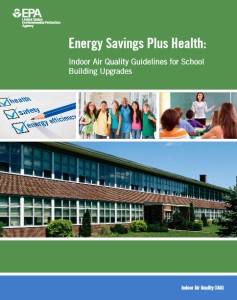
by Brianna Crandall — October 20, 2014—The U.S. Environmental Protection Agency (EPA) released new guidance on October 17 to help school districts protect indoor air quality while increasing energy efficiency during school renovations.
“This guidance provides commonsense solutions for improving energy efficiency and indoor air quality in schools across the country,” said Janet McCabe, acting assistant administrator for EPA’s Office of Air and Radiation. “By using these guidelines, school districts can cut their energy bills and help ensure that students have a healthy and safe learning environment.”
Both energy management and protection of indoor air quality (IAQ) are important considerations for school facilities management during energy upgrades and retrofits, and schools can protect occupant health by addressing both goals holistically, says EPA. These renovation and construction activities can create dust, introduce new contaminants and contaminant pathways, create or aggravate moisture problems, and result in inadequate ventilation in occupied spaces. EPA’s new guide offers opportunities to prevent and control potentially harmful conditions during school renovations.
The practices outlined in the guidance support schools as healthy, energy-efficient buildings that play a significant role in local communities. According to EPA, nearly 55 million elementary and secondary students occupy our schools, as well as 7 million teachers, faculty and staff. In addition, many communities use school buildings after regular school hours as after-care facilities, recreation centers, meeting places and emergency shelters during natural disasters.
For more than a decade, EPA has made significant strides in protecting children’s health in schools by equipping personnel at the state, district and school level with the necessary knowledge and tools to create healthy indoor environments. The new guidance builds on EPA’s existing programs, such as ENERGY STAR for schools and Indoor Air Quality Tools for Schools, which help schools identify, resolve and prevent air quality problems, often with low- and no-cost measures.
Today, half of the schools in the United States have adopted indoor air quality (IAQ) management plans, the majority of which are based on EPA’s IAQ Tools for Schools, says the agency. However, there are still about 25 million children in nearly 60,000 schools who are not yet protected by IAQ management programs.
Visit the EPA Energy Savings Plus Health: IAQ Guidelines for School Building Upgrades publication page to download the new guidance, and Healthier Schools for Healthier Kids Web page for other valuable school environmental health resources.





